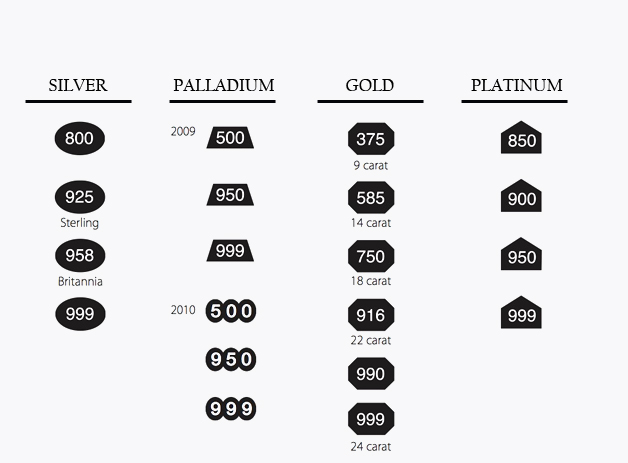Unveiling The Significance Of The CI Jewelry Mark: A Comprehensive Guide
Unveiling the Significance of the CI Jewelry Mark: A Comprehensive Guide
Related Articles: Unveiling the Significance of the CI Jewelry Mark: A Comprehensive Guide
Introduction
With great pleasure, we will explore the intriguing topic related to Unveiling the Significance of the CI Jewelry Mark: A Comprehensive Guide. Let’s weave interesting information and offer fresh perspectives to the readers.
Table of Content
Unveiling the Significance of the CI Jewelry Mark: A Comprehensive Guide

The CI jewelry mark, often referred to as a hallmark, plays a crucial role in the world of jewelry, serving as a silent language that speaks volumes about a piece’s origin, quality, and authenticity. This article delves into the intricate world of CI jewelry marks, shedding light on their history, composition, and the profound impact they have on the jewelry industry and consumers alike.
The Genesis of CI Jewelry Marks
The concept of marking jewelry dates back centuries, with ancient civilizations employing various methods to denote ownership, provenance, or craftsmanship. Early forms of marks included simple symbols, initials, or even the maker’s personal seal. However, the modern CI jewelry mark evolved from the need for standardized quality control and consumer protection.
In the 19th century, as industrialization swept across Europe, the proliferation of mass-produced jewelry led to concerns about counterfeiting and misleading claims about material composition. To address these issues, various countries established hallmarking systems, mandating the use of standardized marks on precious metal items. These marks, often including the maker’s identification, purity of the metal, and the assay office’s stamp, provided a reliable way to verify the authenticity and quality of jewelry.
The Anatomy of a CI Jewelry Mark
A CI jewelry mark typically comprises several elements, each conveying specific information about the piece:
- Country of Origin: The mark usually includes a symbol or abbreviation representing the country where the jewelry was manufactured or assayed. This element helps consumers identify the origin of the piece and understand the applicable hallmarking standards.
- Assay Office: Each country’s hallmarking system designates specific assay offices responsible for testing and stamping jewelry. The mark includes the assay office’s symbol or initials, indicating the location where the piece was examined and certified.
- Purity of Metal: The CI jewelry mark displays the karat or fineness of the precious metal used in the piece. This information allows consumers to ascertain the purity of the gold, silver, or platinum present in the jewelry.
- Maker’s Mark: The mark may include the maker’s initials, a logo, or a unique identification number, enabling consumers to trace the origin and craftsmanship of the piece.
The Importance of CI Jewelry Marks
The significance of CI jewelry marks extends far beyond mere aesthetics. They serve as essential tools for:
- Guaranteeing Authenticity: CI jewelry marks act as a powerful deterrent against counterfeiting, ensuring that consumers are purchasing genuine pieces.
- Ensuring Quality: By indicating the purity of the metal, the mark provides consumers with confidence in the quality and value of the jewelry.
- Protecting Consumers: The presence of a CI jewelry mark signifies that the piece has been tested and certified by a reputable authority, offering consumers a level of assurance and safeguarding them against fraudulent claims.
- Facilitating Trade: Standardized hallmarking systems facilitate international trade in jewelry by establishing a common language for identifying and verifying the quality of pieces.
The CI Jewelry Mark: A Global Phenomenon
The use of CI jewelry marks is not confined to a single country or region. Many nations around the world have established robust hallmarking systems, each with its unique set of regulations and standards. Some prominent examples include:
- United Kingdom: The UK has a long-standing tradition of hallmarking, with marks dating back to the 14th century. The system is overseen by the Assay Office, which operates in four major cities: London, Birmingham, Sheffield, and Edinburgh.
- United States: While the United States does not have a mandatory hallmarking system, it does have voluntary standards for precious metal jewelry, including the use of karat marks to indicate purity.
- European Union: The EU has harmonized its hallmarking regulations, ensuring consistency across member states. The system requires the use of a common mark, including the country of origin, assay office, and purity of metal.
- India: India has a well-established hallmarking system, with the Bureau of Indian Standards (BIS) overseeing the process. The BIS mark guarantees the purity and quality of gold and silver jewelry.
FAQs About CI Jewelry Marks
Q: What is the difference between a hallmark and a CI jewelry mark?
A: The terms "hallmark" and "CI jewelry mark" are often used interchangeably. However, "hallmark" is a broader term referring to any mark or stamp indicating a piece’s origin, quality, or authenticity. "CI jewelry mark" specifically denotes a standardized mark that includes information about the country of origin, assay office, purity of metal, and maker’s identification.
Q: How can I identify a genuine CI jewelry mark?
A: Genuine CI jewelry marks are typically small and discreet, often located on the underside of a piece or on the shank of a ring. They are usually well-defined and sharp, with clear lettering and symbols. If you are unsure about the authenticity of a mark, it is best to consult with a reputable jeweler or gemologist.
Q: Are CI jewelry marks mandatory?
A: The requirement for CI jewelry marks varies by country. Some countries, like the UK and India, have mandatory hallmarking systems, while others, like the United States, have voluntary standards.
Q: What should I do if a piece of jewelry does not have a CI jewelry mark?
A: If a piece of jewelry does not have a CI jewelry mark, it is not necessarily a sign of fraud. However, it is important to exercise caution and to verify the piece’s authenticity through other means, such as obtaining a certificate of authenticity or consulting with a reputable jeweler.
Tips for Understanding and Appreciating CI Jewelry Marks
- Research the Hallmarking System: Familiarize yourself with the hallmarking system of the country where the jewelry was made or assayed. This knowledge will help you interpret the CI jewelry mark and understand its significance.
- Consult with a Jeweler: If you have any questions or concerns about a CI jewelry mark, seek the advice of a reputable jeweler or gemologist.
- Look for Certification: Some pieces of jewelry may come with a certificate of authenticity, which provides additional information about the piece and its hallmarks.
- Learn the Common Symbols: Become familiar with the symbols and abbreviations commonly used in CI jewelry marks, such as karat marks, assay office initials, and country codes.
Conclusion: The CI Jewelry Mark – A Symbol of Trust and Quality
The CI jewelry mark stands as a testament to the enduring value of craftsmanship and the importance of consumer protection in the jewelry industry. It provides a valuable tool for consumers to verify the authenticity and quality of precious metal pieces, fostering trust and confidence in the market. By understanding the intricacies of CI jewelry marks, consumers can make informed decisions and appreciate the heritage and artistry embedded within each piece.






Closure
Thus, we hope this article has provided valuable insights into Unveiling the Significance of the CI Jewelry Mark: A Comprehensive Guide. We hope you find this article informative and beneficial. See you in our next article!
You may also like
Recent Posts
- The Allure Of Cubic Zirconia: A Comprehensive Guide To Its Beauty And Versatility
- The Evolution Of Jewelry Design: Embracing The Power Of CAD
- Corfe Castle: A Journey Through Time In The English Countryside
- Restoring A Precious Symbol: Repairing A Cut Ring
- A Comprehensive Guide To Silver Jewelry In Chennai: Unveiling The City’s Silver Treasures
- A Glimpse Into Kolkata’s Golden Legacy: Exploring City Gold Jewellery
- Navigating The Landscape Of Charitable Giving: Supporting Local Communities In The Wake Of COVID-19
- Corfe Castle And Village: A Journey Through Time
Leave a Reply